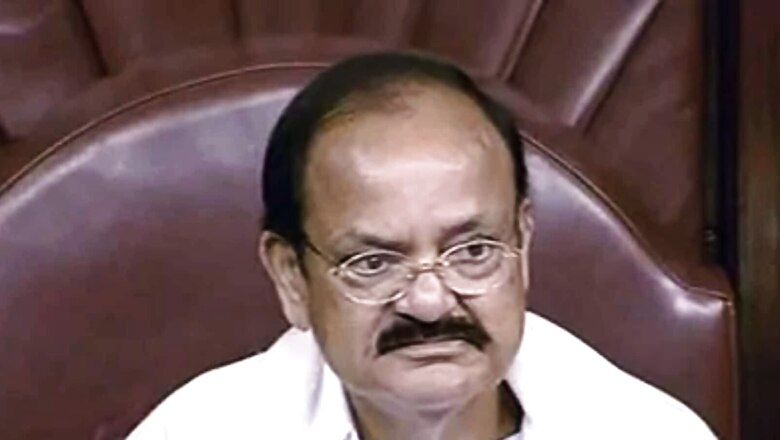
views
The tenure of Rajya Sabha chairman M Venkaiah Naidu was marked by low productivity of the House to start with, but it staged a recovery later. Of the 13 full sessions he presided over till the Budget Session this year, the productivity of the first five sessions has been in the range of 6.8 per cent to 58.8 per cent, while it substantially improved in six of the next eight sessions clocking productivity in the range of 76 per cent to 105 per cent with five sessions working for about 100 per cent of the scheduled time. Fifty-eight issues were primarily responsible for disruptions and forced adjournments of the House during this period, with 57 per cent of the sittings of Rajya Sabha witnessing disruptions and forced adjournments for either part of the day or full day.
A first-of-its-kind publication on the functioning of Rajya Sabha during Naidu's tenure will be released on Monday which highlights that the issue of Special Category Status for Andhra Pradesh was raised in 36 sittings across four sessions starting with the highest number of 24 times during the Budget session of 2018. The next four issues being the one related to the passing of three farm laws and farmers' protests, the Pegasus spyware, the constitution of the Cauvery Water Management Board, and the suspension of 12 members in the winter session of 2021. During Naidu's tenure, about 78 per cent of Rajya Sabha (RS) members daily attended the House, going by their signing the daily attendance register.
While about 3 per cent did not do so, 30 per cent of members reported full attendance in different sessions. Over the years since 1978, for which detailed data regarding the functioning of Rajya Sabha is maintained, the House has come to spend lesser and lesser time on its Oversight function of ensuring the accountability of the executive to the Parliament primarily due to sustained low utilisation of Question Hour.
Such details regarding the functioning of Rajya Sabha during the last five years and the functional evolution of the House since 1978 are contained in a publication titled "Rajya Sabha: 2017-2022 – An Overview", which will be released on August 8. For the first time, the Rajya Sabha Secretariat is bringing out such a publication on the five-year tenure of a chairman to be used for ready reference. It also details the unique initiatives of the chairman to improve the functioning of the House and its committees.
Citing evidence, the publication lists the salient features of the functioning of the House under the chairmanship of Naidu as — improving the productivity of the House during the later part of his tenure further to steady outreach to the leaders and members; regular monitoring of the functioning of the committees resulting in improved performance, among others.
Naidu presided over 13 full sessions, with the holding of 261 sittings during the period as against the scheduled 289 sittings. In the best legislative output per year, 52 Bills were passed in 2019, the highest in 36 years. The lowest ever annual productivity of 40 per cent was recorded in 2018 and the second lowest of 58.8 per cent in 2021.
During the 67 years from 1952 to 2019, the legislative output has been more than one Bill per sitting in only six years — 1976, 1984, 1985, 1993, 2002 and 2003. A total of 194 Private Members' Bills were introduced, while nine Private Members' Resolutions were discussed during this period. A total of 936 of the 3,525 Starred Questions were orally answered. The utilisation of Question Hour during this period has been 41 per cent of the scheduled time. "A total of 58 issues have broadly led to disruptions and forced adjournments of the House either partly or for the full day during these 13 sessions," the publication says.
On an average, about 78 per cent of the members daily sign the attendance register as required for the daily allowance to be paid, while 2.56 per cent never attended the proceedings on a daily basis. About 30 per cent of the members reported full attendance during different sessions. With chairman Naidu regularly urging the members to speak in their mother tongue in the House, the use of Indian languages in the proceedings of the House has substantially increased by about four times during 2018-2020 in comparison with the same during the period of 14 years from 2004-2017. Four languages — Dogri, Kashmiri, Konkani and Santhali — have been used for the first time in 2020 since the House came into being in 1952.
The productivity of Rajya Sabha has been declining since 1995 for every reference period corresponding to the tenures of different governments, the publication said, adding that in the last 70 years since the Rajya Sabha came into being in 1952, the governments of the day did not have majority in the House for 40 years, including for over the last three decades in succession. While the House functioned mostly for 400 to 500 hours per year during 1978-1990, it fell to over 300 hours or more per year subsequently and dropped to below 300 hours per year since 2010.
Analysis of time spent by the House on different items of business for 41 years since 1978 revealed that Rajya Sabha has been evolving more as a deliberative body. It said 33.40 per cent of the time of the House was spent on issues of public importance during 1978-2004; 41.42 per cent during 2005-2014 and 46.59 per cent during 2015-2019.
Read the Latest News and Breaking News here




















Comments
0 comment